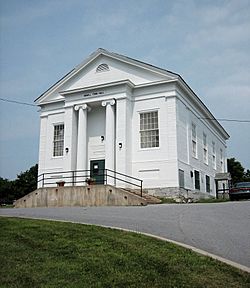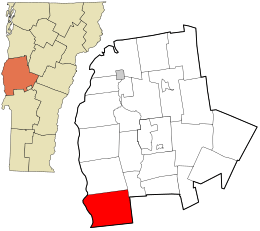Orwell, Vermont facts for kids
Quick facts for kids
Orwell, Vermont
|
|
|---|---|

Orwell town hall
|
|
| Nickname(s):
"The Fortress of America"
|
|
| Motto(s):
"First in Revolution, First in Recreation"
|
|

Location in Addison County and the state of Vermont.
|
|
| Country | United States |
| State | Vermont |
| County | Addison |
| Area | |
| • Total | 49.7 sq mi (128.6 km2) |
| • Land | 47.2 sq mi (122.2 km2) |
| • Water | 2.5 sq mi (6.5 km2) |
| Elevation | 381 ft (116 m) |
| Population
(2020)
|
|
| • Total | 1,239 |
| • Density | 26/sq mi (10.1/km2) |
| Time zone | UTC-5 (Eastern (EST)) |
| • Summer (DST) | UTC-4 (EDT) |
| ZIP codes | |
| Area code | 802 |
| FIPS code | 50-53725 |
| GNIS feature ID | 1462168 |
Orwell is a small town located in Addison County, Vermont, United States. It's known for its history and beautiful natural areas. In 2020, about 1,239 people lived here.
One of the most important historical sites in Orwell is Mount Independence. This was once the largest fort built by American forces during the American Revolutionary War. Today, this 300-acre site is a special historic place in Vermont.
Contents
Exploring Orwell's Location and Landscape
Orwell is found in the southwest part of Addison County. Its western edge touches the border between New York and Vermont. This border runs right through the middle of Lake Champlain, a large and famous lake.
Neighboring Towns and Natural Features
Orwell shares its borders with several other towns. To the north is Shoreham, and to the northeast is Whiting. To the east and southeast, you'll find Sudbury, and to the south is Benson. These last two towns are in Rutland County.
Across Lake Champlain, in New York, are the towns of Putnam, New York and Ticonderoga, New York. Mount Independence, which is about 306 feet tall, is located in the northwest part of Orwell. It offers great views of Lake Champlain and Ticonderoga.
Size and Waterways
The total area of Orwell is about 128.6 square kilometers (or 49.7 square miles). Most of this area, about 122.2 square kilometers (47.2 square miles), is land. The remaining 6.5 square kilometers (2.5 square miles), or about 5%, is covered by water, mainly from Lake Champlain.
Important Roads in Orwell
Two main roads help people travel through Orwell. Vermont Route 22A goes north towards Vergennes and south to Fair Haven. From Fair Haven, it continues into New York.
Vermont Route 73 crosses Route 22A just west of Orwell's town center. This route goes east to Brandon and northwest to the Ticonderoga–Larrabees Point Ferry. This ferry is a fun way to cross Lake Champlain.
Orwell's Population Over Time
| Historical population | |||
|---|---|---|---|
| Census | Pop. | %± | |
| 1790 | 778 | — | |
| 1800 | 1,376 | 76.9% | |
| 1810 | 1,849 | 34.4% | |
| 1820 | 1,730 | −6.4% | |
| 1830 | 1,598 | −7.6% | |
| 1840 | 1,504 | −5.9% | |
| 1850 | 1,470 | −2.3% | |
| 1860 | 1,341 | −8.8% | |
| 1870 | 1,192 | −11.1% | |
| 1880 | 1,351 | 13.3% | |
| 1890 | 1,265 | −6.4% | |
| 1900 | 1,150 | −9.1% | |
| 1910 | 1,065 | −7.4% | |
| 1920 | 942 | −11.5% | |
| 1930 | 835 | −11.4% | |
| 1940 | 876 | 4.9% | |
| 1950 | 902 | 3.0% | |
| 1960 | 826 | −8.4% | |
| 1970 | 851 | 3.0% | |
| 1980 | 901 | 5.9% | |
| 1990 | 1,114 | 23.6% | |
| 2000 | 1,185 | 6.4% | |
| 2010 | 1,250 | 5.5% | |
| 2020 | 1,239 | −0.9% | |
| U.S. Decennial Census | |||
The population of Orwell has changed quite a bit over the years. The chart above shows how many people have lived in the town since 1790. In 2000, there were 1,185 people living in Orwell. These people lived in 441 households, and 340 of these were families.
Who Lives in Orwell?
In 2000, most of the people living in Orwell (over 99%) were White. A small number of people were from other racial backgrounds. About 27% of the population was under 18 years old, meaning there are many young people and families in Orwell. The average age in the town was 39 years old.
Orwell's Rich History

Orwell has a fascinating past, especially during the American Revolutionary War.
Mount Independence: A Revolutionary War Site
After Fort Independence was built on Mount Independence in 1775, American soldiers bravely defended the area. Life at Mount Independence was tough for these soldiers, especially compared to the more comfortable conditions at Fort Ticonderoga across the lake. Soldiers often went back to their farms nearby to take care of their homes.
The fort was sometimes controlled by the British and sometimes by the American colonists. Eventually, it was left empty when the fighting in the northern part of the war ended.
Peace, Progress, and a Unique Law
After the war, Orwell experienced a time of peace and happiness. However, this good time was followed by some sad events in the 1870s. During this period, when people tried to bring more industry to the farms, several young men were hurt in a farming accident.
This tragedy was deeply felt by the community. Because of it, the town decided to ban industrial farming equipment later that year. This old law, which limits the use of "Modern Farm Machinery of All Kinds," was never officially removed. It's still a curious law on the books that the town has chosen to keep!
Modern Challenges and Town Identity
In the late 1990s, Orwell tried to get a fast-food restaurant to open in town. This would have been a convenient stop for travelers between Whitehall, New York, and Vergennes, Vermont. However, people from nearby towns didn't want this to happen. They felt it would spoil the natural beauty of the Vermont countryside.
Orwell is sometimes called "The Fortress of America." The town's motto, "First in Revolution, First in Recreation," reflects its important history and its focus on outdoor activities.
Famous People from Orwell
Many interesting people have connections to Orwell, Vermont. Here are a few:
- Louis Winslow Austin: A famous physicist.
- Tully Blanchard: A well-known professional wrestler.
- Henry C. Bottum: A member of the Wisconsin State Assembly.
- Roswell Bottum: A member of the Vermont House of Representatives.
- Sarah E. Buxton: Also a member of the Vermont House of Representatives.
- John Catlin: He was the acting governor of the Wisconsin Territory for a time.
- Nathaniel Colver: A Baptist minister, someone who worked to end slavery, and an educator.
- Marsena E. Cutts: A politician.
- Henry Kent Hewitt: An Admiral in the United States Navy who commanded the US 8th Fleet during World War I and World War II.
- William P. Kellogg: A US senator and the 26th governor of Louisiana.
- William Smith: The Paymaster-General for the U.S. Army.
See also
 In Spanish: Orwell (Vermont) para niños
In Spanish: Orwell (Vermont) para niños

